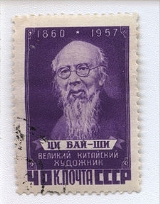
Qi Baishi
Overview
China
Chinese civilization may refer to:* China for more general discussion of the country.* Chinese culture* Greater China, the transnational community of ethnic Chinese.* History of China* Sinosphere, the area historically affected by Chinese culture...
painter
Chinese painting
Chinese painting is one of the oldest continuous artistic traditions in the world. The earliest paintings were not representational but ornamental; they consisted of patterns or designs rather than pictures. Early pottery was painted with spirals, zigzags, dots, or animals...
.
Born to a peasant family from Xiangtan
Xiangtan
Xiangtan is a city in China's Hunan Province that is located on the lower reaches of Xiang river. The hometowns of several founding leaders of the Chinese Communist Party, including Mao Zedong, Liu Shaoqi, and Peng Dehuai are in the Xiangtan Municipal District, as well as the hometowns of Qing...
, Hunan
Hunan
' is a province of South-Central China, located to the south of the middle reaches of the Yangtze River and south of Lake Dongting...
, Qi became a carpenter at 14, and learned to paint by himself. After he turned 40, he traveled, visiting various scenic spots in China. After 1917 he settled in Beijing
Beijing
Beijing , also known as Peking , is the capital of the People's Republic of China and one of the most populous cities in the world, with a population of 19,612,368 as of 2010. The city is the country's political, cultural, and educational center, and home to the headquarters for most of China's...
.
He is perhaps the most noted for the whimsical, often playful style of his watercolor works.
Some of Qi's major influences include the early Qing Dynasty painter Bada Shanren (八大山人 or Zhu Da) and the Ming Dynasty artist Xu Wei
Xu Wei
Xu Wei was a Ming Chinese painter, poet and dramatist famed for his artistic expressiveness. Revolutionary for its time, his painting style influenced and inspired countless subsequent painters, such as Bada Shanren, the Eight Eccentrics of Yangzhou, and the modern masters Wu Changshuo and Qi...
(徐渭).
His pseudonyms include Qí Huáng (齊璜) and Qí Wèiqīng (齐渭清).
Unanswered Questions

